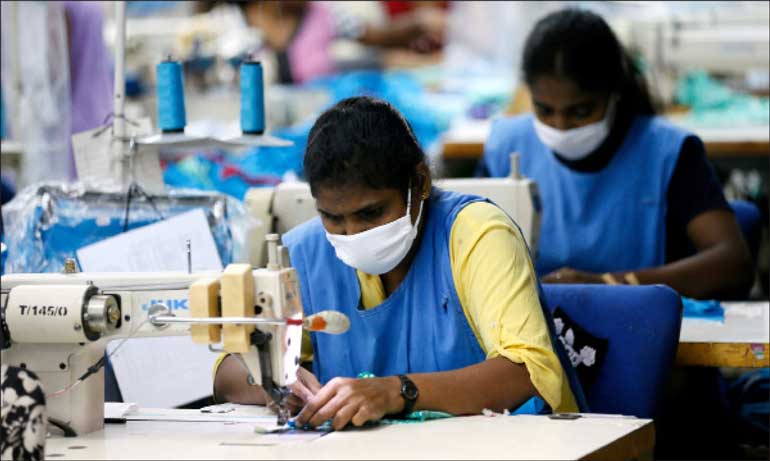Monday Apr 21, 2025
Monday Apr 21, 2025
Tuesday, 30 January 2024 00:07 - - {{hitsCtrl.values.hits}}
 The time of apparel exports is over. If not apparel, what?
The time of apparel exports is over. If not apparel, what?
 Every few years, Sri Lanka’s weakness in manufacturing comes up as the cause of our economic malaise. Economic growth through services is not real, they argue. In the most recent iteration, the slogan is that of a production economy, code for manufacturing.
Every few years, Sri Lanka’s weakness in manufacturing comes up as the cause of our economic malaise. Economic growth through services is not real, they argue. In the most recent iteration, the slogan is that of a production economy, code for manufacturing.
The need for local production is indisputable. But one must avoid the interpretation of local production as being limited to manufacturing, agriculture, and resource extraction, as is implied by the proponents of the production economy. The implication that local production must be protected by high tariffs and other means, which is a holdover from the 1970s, must also be eschewed. Demographic factors such as the slow growth of the work force and its potential contraction due to declining fertility and the pressures of the existing population on land in regions well served by transport infrastructure must be taken into account.
The most important question to ask is why manufacturing is weak in Sri Lanka.
Infrastructure
Infrastructure is what individual citizens or enterprises cannot provide for themselves in an economically efficient manner. It makes sense for the Government to build a well-designed and constructed road than for one individual or enterprise to do so. There are no economic incentives for one entity to bear the costs of a road that will be used by many, unless it is a toll road.
What happens when Governments do not adequately invest in infrastructure is that individuals and enterprises devise workarounds. The Government fails to deliver adequate electricity; firms invest in expensive and polluting diesel generators. The Government under-provides public transport. The result is companies running bus services for their employees (with more downtime and, therefore, greater inefficiency) and individuals investing in motor bikes, three-wheelers, and cars that cause congestion and pollution for all.
Good infrastructure broadens the palette of possibilities for enterprises and individuals. For example, few energy-intensive industries (e.g., ceramics) have been established in Sri Lanka for several decades. There is no business case because energy is expensive. If good infrastructure policy and implementation ensures stable and inexpensive energy supplies, we are likely to see greater investment in manufacturing. One reason investments occur in services and in light manufacturing is lower dependence on energy inputs.
A greatly neglected infrastructure is that of waste disposal. Manufacturing generates more waste than services. Absent facilities to process waste in an economical way that will minimise harm to the environment, manufacturing will be unviable. The owners of the factory in Rathupaswala and the workers did not come out as winners from the conflict with those who lived around the factory.
Sri Lanka is 42nd in population density, behind only the Maldives, Bangladesh and India in our region. However, the uneven nature of population distribution (with high concentrations in the Southwest quadrant) has made it difficult to allocate land for factories and to provide facilities essential for waste disposal. People may like industrialisation in the abstract, but object to its concrete manifestations in their neighbourhoods.
Markets
With any kind of production, the first question is whether there is demand for what is produced. If the productivity of Sri Lankan rice cultivation were to significantly increase, serious problems of storage and price maintenance would arise because there is no foreign demand for the rice produced here. Decision making regarding the promotion of local production of any kind must begin from the demand side, especially demand in markets other than Sri Lanka, and not from what various people outside the production-marketing process think can be produced.
Trade agreements and foreign investment facilitate market access. Trade agreements yield lower tariffs in the markets that are being exported to, increasing the attractiveness of the product to buyers. They may also reduce or eliminate non-tariff barriers such as overly complicated inspections and certifications. Government should strive to overcome primitive antipathy to trade agreements. However, trade agreements will not yield results if enterprises engage in market discovery and close the deals.
Producing simply for the domestic market is not an option because the Sri Lankan economy in the 21st Century cannot function without the import of critical inputs, such as fuel (the largest single component, amounting in 2022 to 27% of all imports; in the 15-20% range in more normal years) and fertiliser, as was well demonstrated when imports were curtailed in 2022. Without imports, we cannot export. Without exports, we cannot pay for essential imports.
Especially in manufacturing, this requires scale. The local market alone will not yield the required scale economies, requiring production for both external and domestic markets. To succeed in the supply of goods and services to external markets, it is necessary to be competitive in terms of price and quality. The discipline imposed by this pressure will yield lower prices and better quality for domestic consumers as well.
Should the State promote manufacturing?
President Premadasa’s rural garment factory initiative illustrates the challenges. He did not want the State to establish garment factories. He was clear about who should operate garment factories in the rural areas: private firms who were already in the industry. They would be responsible for the technology, the investment, the recruitment of workers, and, most importantly, ensuring that the product had a market.
The companies had some incentives to go to the rural areas. More willing and trainable workers were available there for lower salaries. They had disincentives too: power supplies, transport to and from the port were unreliable and costlier than in the cities. What the Government did was to use carrots and sticks to achieve the relocation.
That was a different time. Almost all apparel exports occurred under licenses that allowed them to enjoy preferential conditions from quotas. The license gave leverage to the Government. Now, Government lacks such leverage. Many of the factories then established in urban and rural areas went out of business once the quota regime ended. Those that survive have adapted to the new market environment, adding greater value to their product.
Contrast this with how state-owned industries respond to changes in demand. Taxpayers were paying the salaries of workers at the jute factories taken over by the Bangladesh government decades after demand dried up.
Should the State decide priorities?
The time of apparel exports is over. If not apparel, what? Is the Government capable of identifying what we should produce for export? Isn’t it better to leave that to the entrepreneurs?
What can the Government do? Remove whatever barriers enterprises face. If information gaps exist, help bridge them. But in many cases the most helpful thing Government can do is to improve infrastructure services.
It appears that the biggest barrier is capital. The existence of large conglomerates (e.g., John Keells Holdings) and the emergence of new ones (e.g., Softlogic) is prima facie evidence that the capital markets are inefficient. A true entrepreneur has difficulty raising capital. Those with access to capital appear to be oriented to low-risk, quick-return activities. Therefore, both gravitate toward services. This is not something Government actively does. But it could be an outcome of wrong Government policies.
If, after all this, no manufacturing activities commence, what should the Government do?
Nothing. It could act to lower the various barriers that include, but are not limited to, infrastructure and access to capital. But under no circumstances should it venture into 1970s style direct investment in, and operation of, factories.
The uncoordinated reluctance of countless decision makers who are risking their money should tell us that Sri Lanka does not have a comparative advantage in manufacturing. Their reluctance should always trump the decisions of those who are recommending the risking of other people’s money.
Discover Kapruka, the leading online shopping platform in Sri Lanka, where you can conveniently send Gifts and Flowers to your loved ones for any event including Valentine ’s Day. Explore a wide range of popular Shopping Categories on Kapruka, including Toys, Groceries, Electronics, Birthday Cakes, Fruits, Chocolates, Flower Bouquets, Clothing, Watches, Lingerie, Gift Sets and Jewellery. Also if you’re interested in selling with Kapruka, Partner Central by Kapruka is the best solution to start with. Moreover, through Kapruka Global Shop, you can also enjoy the convenience of purchasing products from renowned platforms like Amazon and eBay and have them delivered to Sri Lanka.
Discover Kapruka, the leading online shopping platform in Sri Lanka, where you can conveniently send Gifts and Flowers to your loved ones for any event including Valentine ’s Day. Explore a wide range of popular Shopping Categories on Kapruka, including Toys, Groceries, Electronics, Birthday Cakes, Fruits, Chocolates, Flower Bouquets, Clothing, Watches, Lingerie, Gift Sets and Jewellery. Also if you’re interested in selling with Kapruka, Partner Central by Kapruka is the best solution to start with. Moreover, through Kapruka Global Shop, you can also enjoy the convenience of purchasing products from renowned platforms like Amazon and eBay and have them delivered to Sri Lanka.